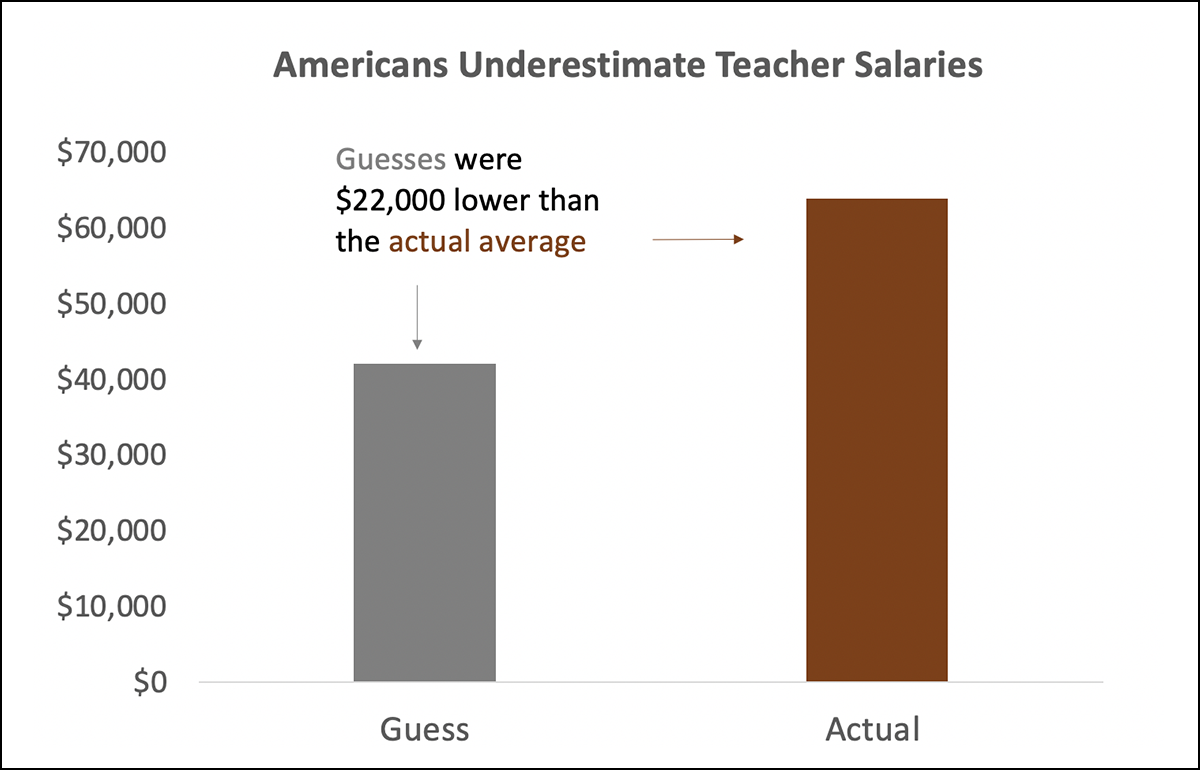Wrong Ideas about Teacher Pay, Happiness May Keep Students from the Profession
Aldeman: Nonprofit finds that changing these 2 misconceptions makes teaching middle and high school more attractive.

Get stories like these delivered straight to your inbox. Sign up for The 74 Newsletter
Teachers generally like teaching. They stay in their chosen profession about as long as accountants or social workers stay in theirs.
Teachers may not get rich, but they live comfortably middle-class lives. Plus, teachers get to retire a couple of years earlier than other workers.
Those are some of the positive narratives that policymakers need to amplify and repeat if they want to convince more young people to go into teaching, according to Get the Facts Out, a partnership between the Colorado School of Mines and six national STEM societies.
The Get the Facts Out campaign started with a radical premise: To get more young people to consider teaching, it should begin by asking students about their perceptions of the profession. With funding from the National Science Foundation, the researchers found some surprising things — like nearly half of science, technology, engineering and math majors consider becoming a K-12 teacher.
They also found that many young people who decide not to pursue teaching give low pay as the main reason. But when the Get the Facts Out team followed up and asked what salary would make them reconsider, the students gave numbers that were in line with current teacher compensation.
In other words, more young people could be convinced to pursue teaching careers in math and science if they were exposed to accurate data. The researchers point to common misperceptions around salary and job satisfaction that are keeping young people from becoming educators.
Misperception #1: Teachers don’t earn very much
In 2021, Education Next asked a random sample of Americans to guess how much the average teacher earned in their state. Those guesses weren’t just wrong, they were consistently too low — by about 50%, or about $22,000. According to the latest data from the National Education Association, the average teacher salary in 2021-22 was $66,745.

The same disconnect appeared when the American Physical Society led a survey of college STEM majors. Its researchers asked students to guess how much teachers in their state earned. Again, their estimates were thousands of dollars lower than the actual salaries.
The researchers then took it one step further and asked those same students how much money they would need to earn one and five years out of college to consider teaching. It turns out that students desired salaries very similar to what teachers actually earned; their misperceptions about pay were turning them away from the classroom.
For anyone wanting to put this insight into practice, the National Education Association’s annual Rankings and Estimates report is an excellent resource for the state-level data (the 2023 version is here). Precise district-level numbers can be somewhat harder to find, but NCTQ has teacher contracts and salary schedules for 145 of the largest districts in the country, and contracts are often posted on district or local union chapter websites.
Misperception #2: Teachers don’t like teaching
It would be easy to get lost in negative news stories about the teaching profession, but Get the Facts Out leaders Wendy Adams and Drew Isola point to a 2013 Gallup survey in which teaching came out as one of the top occupations for overall well-being. More recently, I analyzed the long-running General Social Survey and found that teacher job satisfaction is high and has been remarkably stable over time, even during the pandemic and its aftermath.
Another point of evidence is the objective data on turnover rates across occupations. Consider Census Bureau data compiled by USA Facts. The nonprofit organization analyzes publicly available datasets and recently looked at the percentage of employees who switched roles or stopped working entirely. From 2017-21, K-12 teachers were far down the list of occupations ranked according to departure rates.
In fact, K-12 educators stayed in their chosen profession at similar rates as civil engineers, social workers, postsecondary teachers and police officers stayed in theirs. According to the Census Bureau data, about 10% to 11% of teachers left their profession, compared with 15% of civil engineers, 13% of social workers and 9% of police officers.

This is not a new or one-time finding. In 2007, Doug Harris and Scott Adams published a peer-reviewed study showing teachers had similar turnover rates as social workers and nurses. A 2012 study found that people who temporarily left teaching were as likely to come back as professionals in other fields were to return to theirs.
The Get the Facts Out team has tested the effects of its recruiting messages and found that students who were exposed to their training materials saw large improvements in the accuracy of their perceptions about teacher pay and their awareness of things like loan forgiveness programs. Time will tell if these informational changes will ultimately shift behavior, but for now, Adams and Isola point to data showing a 33% increase on pre- and post surveys in the percentage of students saying they wanted to teach middle or high school.
Policymakers can take heart from these lessons as well. If they are worried about the teacher pipeline in their state or community, they might be able to entice more young people into the profession by highlighting these positive aspects.
Get stories like these delivered straight to your inbox. Sign up for The 74 Newsletter


